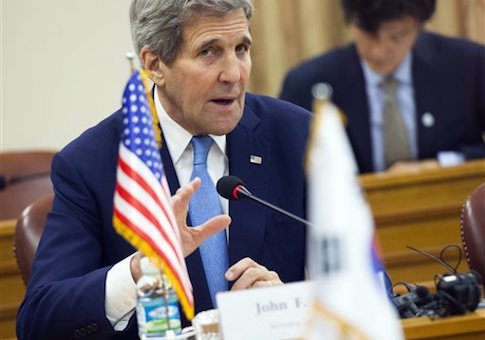Secretary of State John Kerry said in South Korea on Monday that the United States is continuing to seek the deployment of highly effective missile defenses there that are opposed by China.
However, the contentious issue of sending Terminal High-Altitude Area Defense, or THAAD, batteries to bolster forces against North Korean missiles was not raised in closed-door meetings between Kerry and South Korean officials.
THAAD deployment was requested last year by Gen. Curtis Scaparrotti, commander of U.S. Forces Korea (USFK), amid growing concerns regarding North Korean missiles targeting South Korea. Site surveys for THAAD bases were carried out last year—a sign of the relative urgency of the commander’s request.
Kerry said during a meeting with USFK members and leaders in Seoul that provocative activities by North Korean leader Kim Jong Un has created a "dangerous" situation on the Korean Peninsula.
"And nobody quite knows what a reckless person like this fellow will do, so you have to be prepared for every eventuality, which is why we redeployed some ships and forces, and why we’re talking about THAAD and other things today," Kerry said.
It was the only reference to the missile defense system during Kerry’s visit, which followed a two-day visit to China, where Chinese aggression in the South China Sea was discussed.
The South Korean Foreign Ministry, in response to reports of the THAAD comments, issued a statement saying the topic was not raised during Kerry’s meeting with Foreign Minister Yun Byung-se. The subject of THAAD deployment also did not come up during a joint press conference between Kerry and Yun.
China, according to U.S. officials, has launched a major influence campaign against a THAAD deployment in South Korea. Chinese President Xi Jinping, who has met several times with South Korean President Park Geun-hye, specifically called on Seoul not to deploy a THAAD system. In exchange, Xi is said to be offering South Korea major financial and trade incentives.
Beijing’s anti-missile defense gambit appears to be part of a larger Chinese strategic influence effort designed to coax Seoul into shifting its allegiance from the United States to China, analysts say.
China is opposing U.S. and allied missile defenses in Asia as a threat to its large-scale ballistic missile forces. Chinese government spokesmen have said THAAD’s high-powered radar could be used to counter Chinese missiles in Northeast China.
THAAD’s high-powered X-band radar can spot, track, and identify missile launches over long distances and at very high altitudes.
The current House defense authorization bill, passed last week, mentions the THAAD controversy and says the missile defenses would provide mutual benefits.
THAAD in South Korea would "enhance and complement the current air and missile defense capabilities maintained by both countries, including across the entire ballistic missile kill chain, on the peninsula," a House report on the bill states.
If the Seoul government approves the deployment it would represent "a further demonstration of the collective security commitments of both countries," the report said.
Scaparrotti, the USFK commander, told a Senate hearing in April that he wants THAAD for use against Pyongyang’s missile forces. The North currently deploys several hundred missiles, most of them close-range and short-range weapons for use on the peninsula, he told the Senate Armed Services Committee.
"We have been taking steps both in material capability in terms of our ballistic missile defense to counter that, as well as work with the Republic of Korea and their ballistic missile defense," he said.
Currently, less-capable Patriot Pac-3 missile defenses are deployed at U.S. military bases in South Korea. THAAD batteries currently are deployed at the U.S. military hub of Guam in the south Pacific.
THAAD defenses would augment land-based Patriots and Navy Aegis sea-based missile defenses.
The United States has been seeking to develop regional missile defenses with both Japan and South Korea to counter both North Korean and Chinese missile threats.
Scaparrotti said THAAD deployment is "a decision for South Korea, having to do with the defense of their country, and from my perspective as a commander there, defense of our troops."
The U.S. military currently has some 28,000 troops in South Korea.
North Korea has been developing asymmetric warfare capabilities that include nuclear weapons and missile delivery systems, including road-mobile and submarine-launched long-range missiles and cyber warfare capabilities.
Although relations between China and North Korea are said to be strained, the two communist-ruled militaries remain close.
Asked about Chinese opposition to THAAD and whether both countries should push back, Scaparrotti said April 16: "The THAAD system, if employed, is focused on the defense of the Peninsula. That's what it is specialized to do. It doesn't have any influence beyond that."
"The decision process is under way right now," he said. "I can discuss from a military perspective. But you know, from a political and strategic perspective, I think both countries are taking that into consideration right now, in terms of the other impacts that have to do with the employment of THAAD on the peninsula."
Asked about the remarks today, a State Department official said there have been no formal discussions on THAAD deployment with the South Koreans.
"We continue to take the threat from North Korea seriously," the official said adding, "at Yongsan this afternoon, the secretary was attending an internal event and speaking to an internal U.S. audience."
